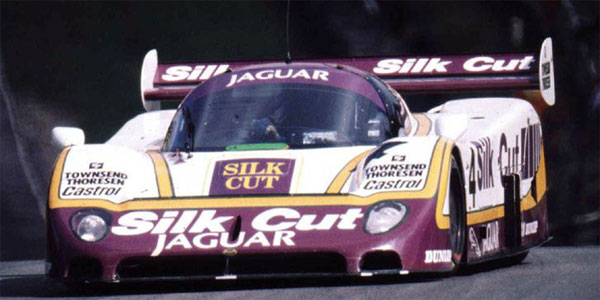30377 view(s)  In the early 1980s two of the most successful Jaguar privateers made plans to bring the marque back to Le Mans. In the early 1980s two of the most successful Jaguar privateers made plans to bring the marque back to Le Mans.
Both Bob Tullius' US based Group 44 and Tom Walkinshaw's Britain based TWR had vast experience with the latest version of Jaguar's V12 and felt it could be a strong competitor in the newly created Group C class.
This would mean taking on the mighty Porsches and that seemed virtually impossible without some structural factory support.
Surprisingly this was granted to both teams with Group 44 continuing to focus on the American IMSA GTP Championship and TWR on the Group C World Championship. This strategy would give Jaguar two chances at Le Mans glory.
The XJR-5 raced at Le Mans with factory backing at Le Mans in 1984 and 1985, with a class victory in the second year as a highlight. There was little chance of an overall victory, so Jaguar's focus was now turned to TWR's project.
Other than using a similar engine, TWR's XJR-6 had little in common with the 'American' car. Tony Southgate was responsible for the design and applied many lessons learned in the abandoned Ford C100 racer. He laid out a carbon fibre monocoque and a highly advanced aerodynamics package with very large ground effects tunnels. It was quite a departure from the norm and would form the mould of all subsequently designed Group C racers. In conjunction with Zytek, TWR developed a fuel injection system of their own for the V12 engine. Their goal was to draw as much power from the engine with enough efficiency to meet the strict Group C fuel restrictions. Displacing 6.2 litres, the naturally aspirated engine produced around 650 bhp in endurance trim.
One of the problems the early TWR XJR's was their high weight, which also meant the engine could not be run at full power to preserve fuel. A victory of the XJR6 in the Silverstone 1000 km race was a clear boost to the moral, although Le Mans still proved a bridge too far with all three cars failing to reach the finish.
 Over the next winter TWR continued their development program and made many (sixtyfour to be precise) detail changes to create the XJR-8 (XJR-7 used for Group 44's last IMSA GTP). The biggest changes were found in the engine bay, which now housed a 7 litre long stroke V12 engine. The XJR 8 also incorporated revised front and rear suspension. Over the next winter TWR continued their development program and made many (sixtyfour to be precise) detail changes to create the XJR-8 (XJR-7 used for Group 44's last IMSA GTP). The biggest changes were found in the engine bay, which now housed a 7 litre long stroke V12 engine. The XJR 8 also incorporated revised front and rear suspension.
The new package proved a winner straight out of box and it dominated the season's sprint races,
LeMans however was a different story, the XJR 8 LMs were fast but let down by many small mechanical problems. Only one of the three cars did manage to finish but many laps down from the winning Porsches.
But in the shorter 1000km races the buig cats dominated. After Le Mans they bounced back by winning at Brands, the Ring and Spa. In 1987 the team scored eight victories , and with almost twice as much points as its nearest competitor, took the constructor's championship. Winning XJR 8 in sprint configuration at the Brands Hatch circuit.
Jaguar XJR 8 dimensions:
Lenght: 4830mm, Width: 2000mm, Height: N/A, Wheelbase: 2710 mm
Sources:Wouter Melissen, www.ultimatecarpage.com | 24 heures du Mans 1987, editions Acla |The rise and fall of Group C
|

